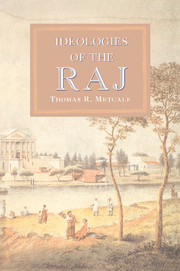6 - Epilogue: Raj, empire, nation
Published online by Cambridge University Press: 28 March 2008
Summary
THE RAJ AND THE EMPIRE
The British Raj in India did not of course exist by itself, or solely in its relationship to Great Britain as the metropolitan power. It participated as well in a larger network of relationships that defined the entire British Empire. Ideas and people flowed outward from India, above all to East and South Africa and to Southeast Asia, while the administrators of the Raj had in turn to take into account events that occurred in Africa, and even in Canada and Australia. Participation in this larger arena opened up fresh territories in which the ideologies of the Raj were to find expression. Such notions as ‘indirect rule’ through compliant princes, and the demarcation of communities on the basis of ethnicity and religion, shaped the working of the British Empire from South Africa to Malaya. In addition, the ties to the larger empire both reinforced India’s ‘distinctiveness’ as a land set apart, above all from white settler dominated colonies, and yet made possible an assertion of India’s membership in a community which secured all of its members equal rights of movement and citizenship. The existence of the British Empire thus forced the British to confront once again the tensions between the two enduring ideals that shaped their rule of India. Was the ideology that sustained the Raj meant to link India as an equal with Britain’s other colonial territories, including those of British settlement, or to reaffirm its ‘difference’?
- Type
- Chapter
- Information
- Ideologies of the Raj , pp. 215 - 234Publisher: Cambridge University PressPrint publication year: 1995

